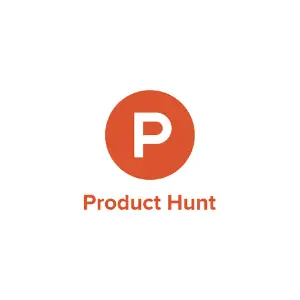“Product Hunt surfaces the best new products, every day. It’s a place for product-loving enthusiasts to share and geek out about the latest mobile apps, websites, hardware projects, and tech creations”
If you work in technology and don’t keep a daily tab of Product Hunt, one could argue that you’re missing out on relevant insider information.
In some ways, Product Hunt is like Techcrunch, except it surfaces new tech products instead of new tech stories.
Tech enthusiasts use it to stay in the know. Emerging startups list themselves to get in front of the people that matter. Investors use it to scour investment opportunities.
The most upvoted product of all time is Startup Stash, a curated directory of 400 resources and tools for startups, launched on Product Hunt in February 2017.
After it launched on Product Hunt, the site went viral, receiving 35k unique website visits & 230k pageviews in just 48 hours.
Startup Stash’s Product Hunt driven popularity contributed to its acquisition, leaving creator Bram Kanstein with both a stash of cash and an increased reputation as a growth leader.
Product Hunt’s most successful launch highlights that the right product, rightly launched on the platform, can generate interest among potential investors, apart from driving users.
But as one Indie Hacker noted, “The web is flooded with success stories of PH Launches, and they never talked about the rest of the 50 apps that flopped for the day.”
Product Hunt is another marketing channel, which, like any other, does not result in more exposure without marrying an innovative product with epic marketing.
Product Hunt’s Growth Story
At the time of writing, Product Hunt ranks in the top 15,000 websites worldwide. In the computer electronics and technology website category, it comes in the top 500, a massive achievement considering the space’s competitive nature.
Before founding Product Hunt, Ryan Hoover worked as a product manager for a San Francisco based gaming startup for three years.
His role involved juggling multiple hats like defining the user experience, creating wireframes, occasionally sending marketing emails, and answering support requests, mostly non-technical work.
Hoover helped scale the startup from a team of six ( 5 engineers and Hoover, managing them all alone ) to a multi-million-dollar revenue generating, 100 person team.
When Hoover left his job in 2013, he had no fixed plan, but he knew he wanted to build something for himself.
“I know it sounds cliché, but I was sick of building things for other people. It’s far more rewarding and easier to create something when you are the consumer.” he said in an essay titled “Planting Seeds.”
After leaving his job, he transitioned into a part-time role, and in the meanwhile, kept exploring other opportunities.
During this time, he created an experimental email list, calling it Product Hunt.
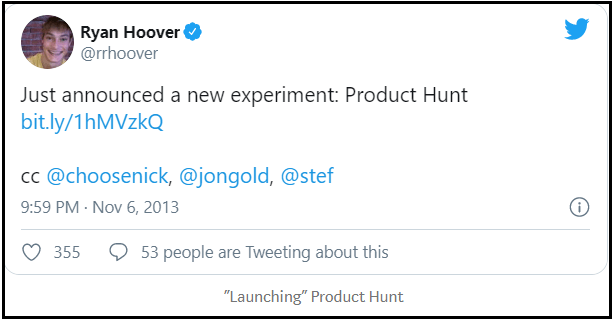
“What cool new products are you using?” A question Hoover often found himself asking in conversations with friends gave birth to Product Hunt.
Hoover started with an email because he lamented the effort needed to develop an MVP. Even a basic Ruby on Rails app would have taken more time than your average programmer because he was non-technical.
The email list didn’t just help test the water; it also made it possible to go from idea to MVP in 20 minutes.
Email lists function as an efficient minimum viable product, both literally and figuratively, for content-driven and curation-focussed startups.
AngelList started as a weekly email sharing a curated list of angel investors. Thrillist began as a men’s lifestyle email newsletter. Timehop started by emailing Foursquare check-ins from a year ago.
A few dozen founders, investors, and startup folks Hoover knew became the initial community’s seeds. Every day, subscribers received an email of newly launched, interesting products.
Some even contributed by sharing products to add to the email. Early adopters loved the daily email, and subscribers grew organically.
The email-first launch helped validate the idea & created a daily habit of checking Product Hunt’s email among subscribers, leveraging the now popular concept of building an audience first, product second.
Encouraged by the community’s positive feedback, Hoover sought his friend Nathan Bashaw’s help to build the “real Product Hunt.”
But they didn’t build the product in a cave. Hoover & Nathan engaged the small, existing community in the building phase.
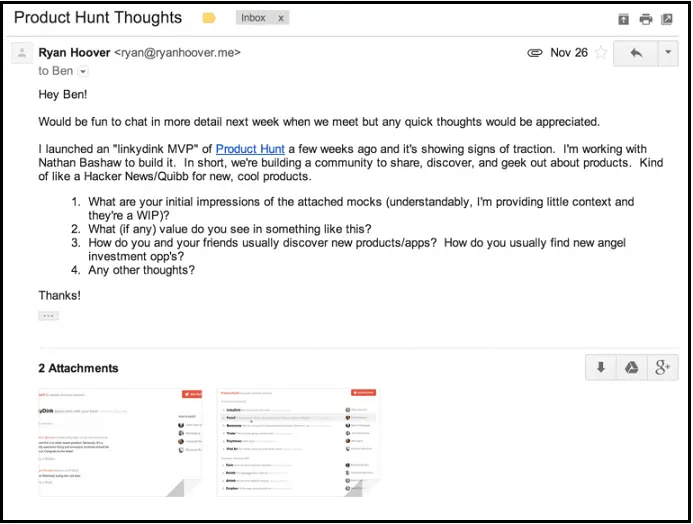
Doing this made the community members feel like they were a part of the project and build a product that actually catered to users.
Five days later, they launched a minimal but fully functional product, whitelisting supporters only, and asked them not to share it publicly.
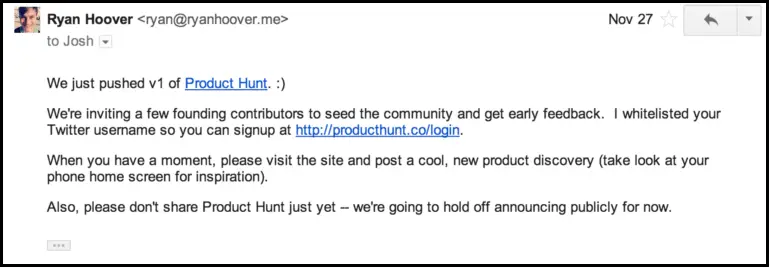
Like a sports fan getting access to limited VIP tickets, users were thrilled, and Product Hunt acquired its first 30 users on that day.
Over the next week, they fixed bugs, gathered additional feedback, and invited a few more people.
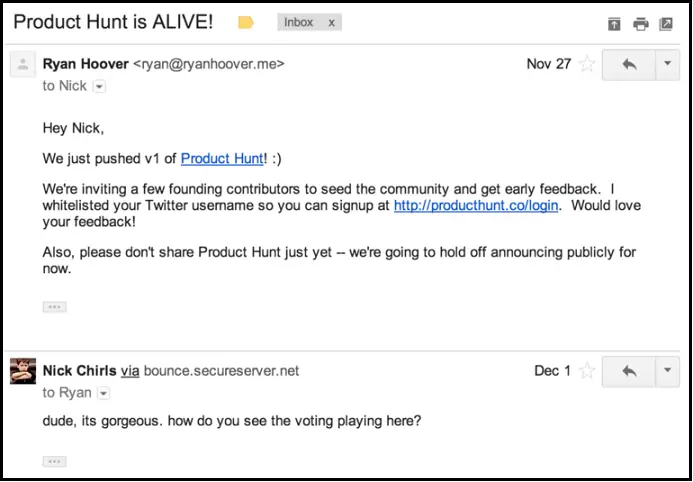
“Your first users matter. We knew how important it was to seed Product Hunt with the right people from the start. Initial users form the community’s culture and once established, it is very difficult to change.” Hoover later wrote, reflecting on generating initial traction.
By the end of the week, Product Hunt had 100 users belonging to the ‘Passionate Tech’ tribe.
Since the right kind of people were now a part of the early community, Hoover reached out to PandoDaily, a popular tech magazine, where he had written guest articles for the public launch.
Once the article was published, they spread the word by emailing users, asking them to do two specific things:
- Posting products on Product Hunt because success depended on having quality products listed.
- Sharing the article within their network ( Many early adopters had a large following and influence )
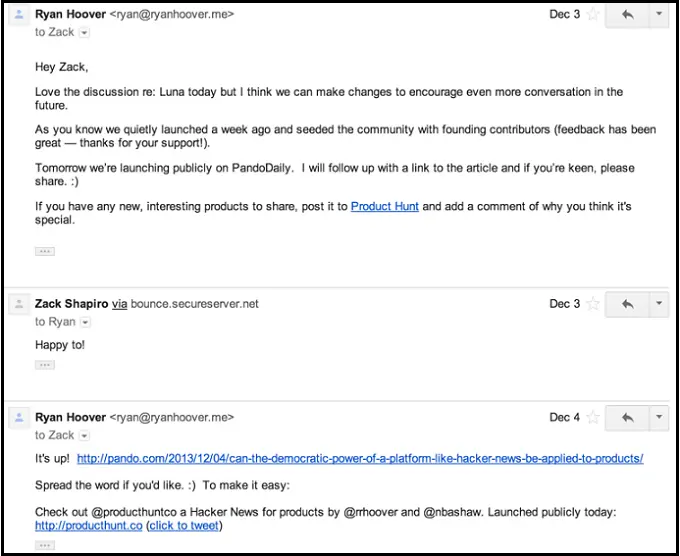
By the end of launch day, Product Hunt had 400 users. An article in Fast Company followed up the PandoDaily piece. Like PandoDaily, Hoover had contributed several articles to the publication, making it easier to get featured. Soon after the article went live, Product Hunt hit the 800 users mark.
After the public launch, Hoover & Nathan kept a close eye on who was signing up.
If an influencer signed up, they sent a personal email inviting them to contribute. To share the Product Hunt’s inception story & build credibility, they included links to the published articles.
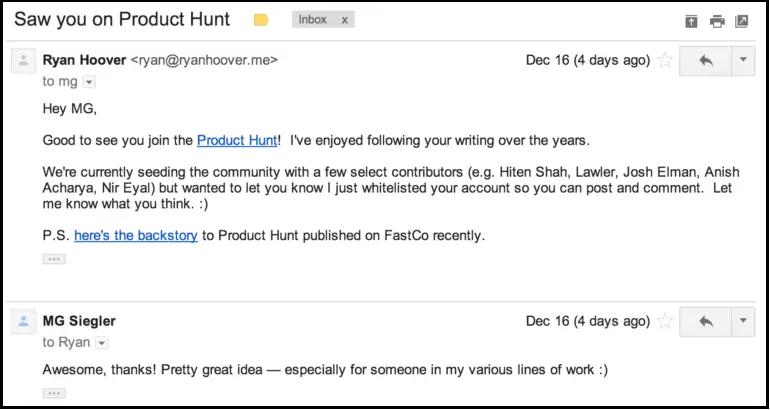
They even asked users for targeted referrals of product people and investors, both the kind of people that would positively impact engagement and increase the community’s overall reputation capital.
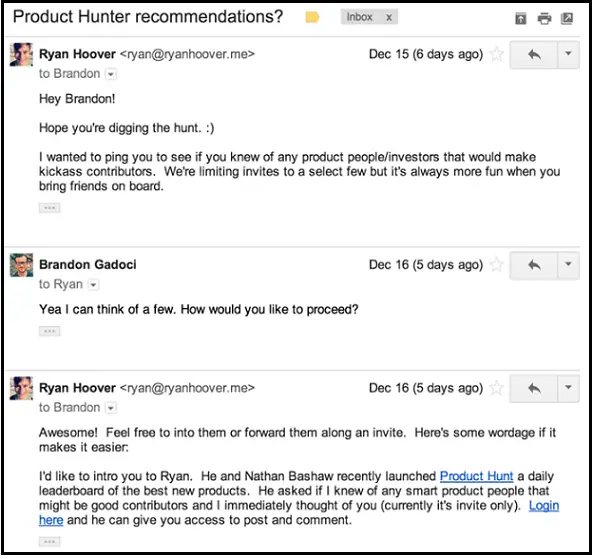
You could say that all this personal emailing & user monitoring could have been automated, but deliberately choosing the slow, manual route ensured three things:
- The early community consisted of highly relevant users that felt part of an elite group.
- It left the impression that the founders were passionate about building the product & growing it.
- Initial users felt humans were listening to them on the other side, not automated software doing what it was trained to do.
Twenty days after the private launch, Product Hunt had acquired its 2000 users, all by doing things that don’t scale, a strategy popularized by investor Paul Graham.
After that, the growth curve trended upwards. In August 2014, Product Hunt raised a $1M seed investment from many renowned investors, including Y Combinator.
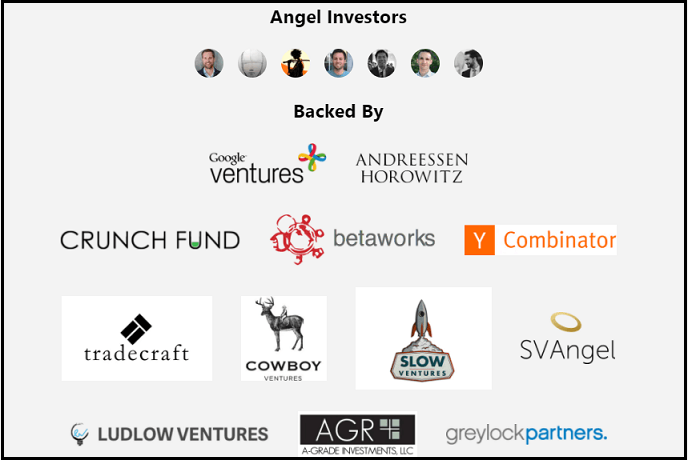
By Dec 2014, a little more than a year after the email MVP launch, 11,576 products had been listed (or hunted in Product Hunt speak), 628,466 upvotes had been cast, 61,497 comments had been posted, 23,501,457 unique product visits had been generated & 12 members had joined the Product Hunt team.
But even as it grew, Product Hunt retained the ethos of engaging the community in product development, listening to user feedback, and even incorporating feature requests.
AngelList Acquisition
All startups need to raise funds (barring exceptions), recruit top talent & find customers. While many options existed to serve these three needs, AngelList addressed only the first two needs. So, when it acquired Product Hunt for $20 million in Dec 2016, it was a match made in heaven.
Since the acquisition, the two products have been loosely integrated, but Product Hunt has continued to operate as an independent platform, maintaining its original, playful operational vibe.
How Product Hunt Makes Money
For most of its journey, Product Hunt was laser focussed on growing an engaged community, innovating ways for makers & consumers to discover and share products.
Not worrying about making money early on was a strategic, intentional decision, complemented by investor capital support.
In 2014, the company generated revenue by paid job listings and selling t-shirts, but the amount was minimal, enough only to pay their Heroku bill for a short time.
It wasn’t until the end of 2017 when the company launched an offering called ‘Ship,’ it started making serious money.
More successful revenue stream launches followed up ship’s success. During the new experiments, the company dabbled through some failed income-generating initiatives, but we’re going to cover the successful ones that currently contribute to the bottom line.
Suppose we were to explain how ‘Product Hunt Makes Money’ in a sentence.
In that case, we would say it has a diversified portfolio of income streams such as Founder Club, Ship, Advertising(6 offerings) & Mentorship mediation from Industry Experts.
But let us run through them one by one, to expound our tweet-sized, compressed answer.
1. Ship
Building a product is easy. Distribution is challenging. Most founders think about marketing when they’re done building, instead of thinking about it the day they start building.
But whether you start reaching out to customers sooner or later, you will need tools to reach out to users.
Ship is a SaaS bundle created by Product Hunt to help makers build an audience, talk to users & grow their audience using a bunch of features:
- Custom landing page builder
- Embeddable widgets
- Embeddable email forms
- Surveys
- Direct & group user messaging
- A/B testing
- Analytics & Webhooks
Apart from these features developed by the Product Hunt team, the bundle also comes with up to $7500 in AWS credits, up to $50,000 in fee-free Stripe processing & direct access to Stripe Atlas, and Clearbit enrichments ( A term used for providing more data on acquired leads )
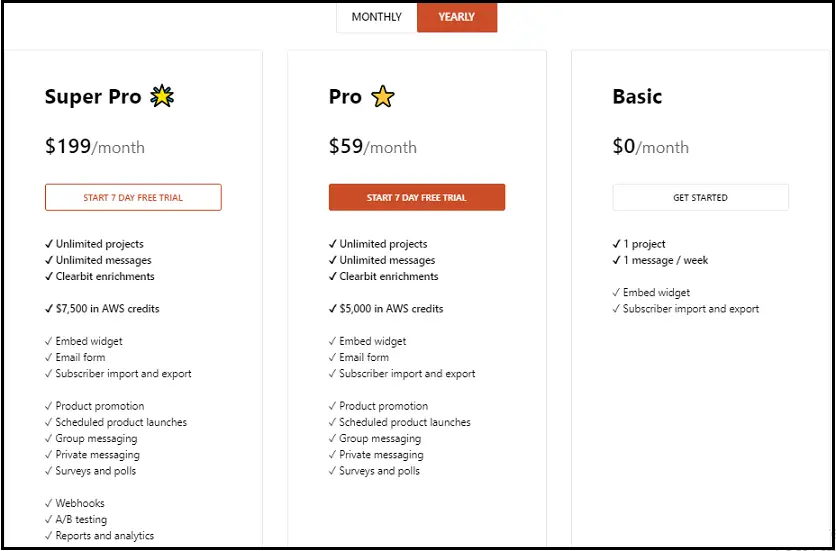
2. Founder Club
As startups grow, the number of tools needed to run them grows together. Founder club is a curated bundle of products and services designed to help & grow startups. Founders get access to >$100,000 in savings for $720/year.
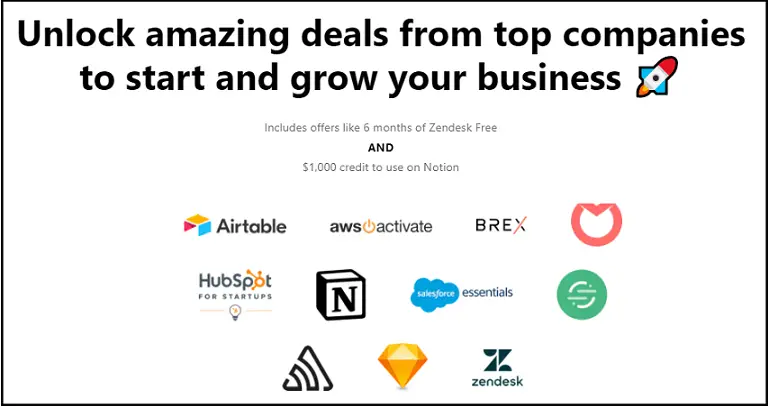
Some popular deals include $5,000 in AWS Credits, $1,000 statement credit and waived card fees for life by Brex, $2,000 in Airtable credits & 40% off on Hubspot for the first year.
3. Advertising
In total, Product Hunt has six advertising offerings, two of which are core to their advertising business.
1. Promoted Product of the Day
Digital advertising is the most commonly used monetization technique for products with an audience. It is easy to implement
( Unless you’re a tech giant like Google or Facebook). It scales. And it brings in money.
But Product Hunt has not just built an audience; it has created a highly engaged community of tech fanatics. And when it comes to digital advertising, the more targeted the audience, the more money the platform can charge ( Note: This is a calculated guess. Product Hunt doesn’t reveal promotion pricing publicly on its website. )
Product Hunt allows only one previously launched organically popular product to be featured on the Product Hunt home page in a day. The toll check ensures that only the best products can pass through their advertising gate.
Limiting access to its coveted audience (only promotion one in a day) instead of opening the flood gates for everybody & only resurfacing old popular products makes the advertising experience better for the users.
It’s a win-win for product enthusiasts, deserving advertisers, and Product Hunt.
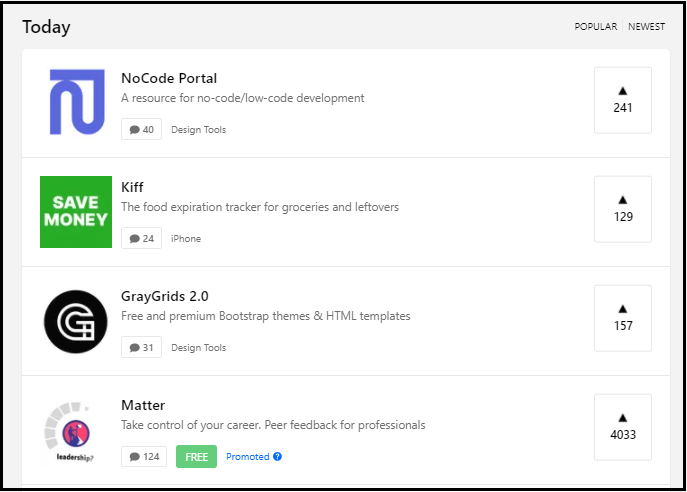
Product Hunt’s Promoted Product for the day appears in the fourth position, with a small Promoted badge next to it.
As we discussed earlier, AngelList, Product Hunt’s parent company, already had a job posting functionality, which complemented Product Hunt’s product discovery.
And AngelList hosts jobs both from some of the fastest-growing startups & Silicon Valley giants. Most of us haven’t heard of it, but it’s where tech geeks go to find their next exciting opportunity.
So what was the need for Product Hunt to launch a job posting offering post-acquisition? Diego Piacentini, long time Amazon veteran, once said in a speech at Stanford’s Graduate School of Business, “It is far better to cannibalize yourself than have someone else do it,”
Product Hunt has a smaller audience pool relative to top portals, but the overly tech enthusiastic audience is more valuable. The platform works like a filter that increases the odds of finding better candidates, giving it the license to charge a minimum of $299 for 30 days per job listing.
The jobs board lists open roles & thousands of email subscribers looking for opportunities receive weekly job emails.

Startups pay extra money to increase visibility by showcasing their listing on the Product Hunt home page.
Email Lead Generation
Whether you have a newsletter based business or want to grow your email subscriber base, this offering helps you connect with interested community members by letting them share their email with you.
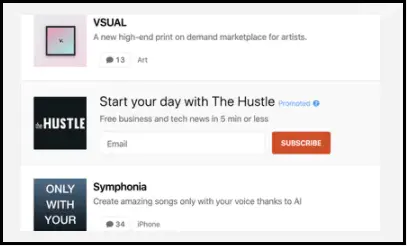
Topic-Based Advertising
Product Hunt segregates products by topics like Productivity, Developer Tools, Artificial Intelligence, Marketing, User Experience, and many more.
When someone launches a product on Product Hunt, they tag it in relevant categories. Users often browse through categories, apart from keeping a tab of daily product launches.
This topic browsing user behaviour turns topics into prime real estate, giving advertisers another effective way to reach people specifically interested in the topic their product falls in.
Newsletter Sponsorship
Every Monday to Friday, hundreds of thousands of subscribers receive a daily email listing the best products of the day.
Considering Product Hunt’s audience and engagement, it’s safe to assume that email open rates and CTR’s might be double of industry benchmarks.
Interested advertisers can reach out to a targeted, highly engaged email subscriber base using Product Hunt’s ‘Newsletter Sponsorship.’
Product Hunt Radio
Radio has made a comeback in the form of podcasts, and Product Hunt using the traditional audio medium’s name to self-identify their
Podcast, the modern audio medium, feels nostalgic.
Following a weekly cadence, the podcast features founders, investors, journalists, and makers, discussing peripheries in the startup and tech space.
Advertisers can reach thousands of dedicated listeners with tailored audio ads using the ‘Product Hunt Radio’ offering.
Note: All advertisers, irrespective of the type of advertising, go through screening.
4. Mentorship
Aspiring/existing entrepreneurs can book a 1 to 1 meeting with industry experts on a range of topics, including product building, social media, PR, design, engineering, and more through the ‘Product Hunt Mentor’ program.
Mentors get to set their fees, but they have to go through a vetting process first. Product Hunt takes a percentage of each call.
Product Hunt Revenue & Valuation
Being a private company, Product Hunt has no obligation to share revenue publicly, and it chooses to exercise the right.
But we can make a reasonable guess that it’s not doing bad financially, considering Hoover has announced two more projects in recent years: Weekend Fund (An early-stage fund) & Your Stack (A new community to share the products you use and love).
With regards to Product Hunt’s valuation, all we know is that AngelList valued it at $20 Million at the time of the acquisition, in 2016.
Thank you for taking the time to read the entire article. If you liked it, you might also like our article covering Google’s Business Model.
